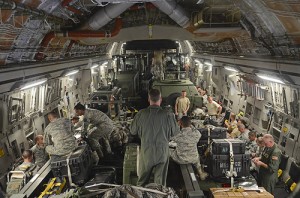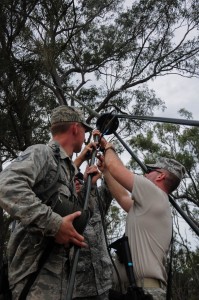2013-12-16 Shortly after the return of the 36th Contingency Response Group from the Philippines, we had a chance to talk with the Commander of the Group.
The 36th CRG and the USMC worked closely together at the Tacloban Air Base to re-open the base to allow for insertion of relief workers and supplies to the highly impacted areas in the Philippines from the Typhoon.
As Col. James, from PACAF, explained earlier about the CRG:
They deployed to Tacloban and worked to open up the airport to become capable of flowing in support capabilities. They had to set up air traffic control support; they had to work to extend the runway ….
They worked with the Filipinos to make sure the kind of safety equipment we needed to maintain sortie rates was available to ensure safety and security. They also focused on getting in the machinery which can facilitate offloading of supplies.
We have interviewed Marines involved in the effort as well, and a general picture is emerging.
The Marines and the USAF worked together with support from the USN to establish an infrastructure to enable relief operations.
This was done within two weeks, and the initial elements of support then left the Philippines.
It was an insert, support and withdraw effort in which the 36th CRG and the USMC played a key role in rapid insertion, and responsible withdrawal.
This was all done with close coordination with the Philippine government and armed forces, which were then in a position to manage the operation as the USMC and USAF pulled its initial assessment and support teams.
The discussion with Col. Tom Livingston, the CO of the 36th CRG, provided important details on the approach and its execution as well as the crucial role of training.
A key concern, which analysts have had about US forces under fiscal pressure, is the atrophy of training, and the central importance of training to operations. This real world event demonstrates once again that training between the USMC and the USAF, on the one hand, and with allies in the region is central to mission success.
SLD: We have visited the CRW in New Jersey. How is the 36th CRG similar and different from the CRW?
Col. Livingston: We have a similar capability but are less resourced. The CRW has equipment both for training and operations. Our equipment is used the same for both.
And we are directly supporting PACOM and PACAF and support Pacific operations. The CRW is tasked worldwide and is a supporting element to the Air Mobility Command.
SLD: Turning to Operation Damayan, what were your first tasks or responsibilities?
Col. Livingston: A few days prior to the storm hitting the Philippines, we provided a scalable capability input to support any effort. Then when the storm hit, we were tasked to provide an on site assessment of Tacloban airfield.
We were tasked to determine what damage to the infrastructure had occurred, primarily in terms of air traffic control capability, the surface and subsurface of the runway, the stress of the map and the security challenges. Would the airfield be able to support a C-17 or simply C-130s?
We first sent the assessment team in to determine answers to these questions. And the team traveled in on a C-130s initially.
We had a planners operating in Manila on the 10th, we did the airfield assessments on the 14th and the team moved into the airfields on the 15th.
SLD: So what did you find?
Col. Livingston: A major challenge from the outset was security. We sent a security team, which worked with the Philippine police to provide for crowd control and management so that we could get the airfield operational.
SLD: From the discussions with the Marines, it was clear that Clark became the Fed Ex type hub to bring in supplies but that Tacloban was essentially close to the areas of devastation and it was important to get it up and running effectively because it was a key spoke in from the hub. Is that a fair way to put it?
Col. Livingston: It is. Our standard package to go out the door is between 90 and 120 people. Originally, we hoped to put 100 into Tacloban but quickly discovered that we had enough dry ground only to have a 50 person team there, and the rest of the team went to Clark.
SLD: The Marines went first, and how did you work with the Marines as you landed at Tacloban?
Col. Livingston: The Ospreys provided a significant early entry force. The Filipinos loved the way the Ospreys could get into remote locations that had no roads, no infrastructure and could be used to bring assessments teams of civilians and representatives for the Filipino government to what what people in the remote areas needed immediately.
And we when we got there, a single marine was working with Filipino air traffic controller to hold the fort and we were able to integrate him into our team and we did the same with the Marines working the airfield as well.

SLD: When you got to Tacloban, the Marines were already there and how important has the training between you and the Marines been to prepare for the mission?
Col. Livingston: Crucial. We train with the Marines in Nepal during a HA/DR field training exercise in Katmandu and in Forager Fury, an expeditionary exercise done in the Marianas islands. We also worked with coalition allies in Cope North and General Carlisle would like to expand such efforts, and to help shape more allied capability, which is congruent with what we can bring.
Indeed, one outcome of the relief effort is expanded interest by the Philippine forces in building CRG like capabilities, something we would work with them on if they wished.
SLD: Has the fiscal tightening affected your training?
Col. Livingston: It has. We have been doing our training pretty much confined to Guam over the past year and a half. In the past, for example, CRG has provided a logistical footprint for providing humanitarian medical packages and we have had to scale that down without a CRG footprint.
We have not been able to get on the road nearly as much as in the past.
We have expanded the role of tabletop exercises to train for operations with US and allied forces.
SLD: From a personal point of view, how did the team react to events?
Col. Livingston: An event like this puts pressure on everyone. And it is gratifying to to see how the team responded to the pressure and rose to the occasion.
The Philippine forces worked day and night to save their people and many heroes on the Filipino side emerged.
And we were able to work with these folks and to shape a good outcome under horrific circumstances.
For us, the first 96 hours were packed and challenging. Everyone on the ground was working continuously and under extreme pressure to get the supplies flowing into the area. Within 12 hours, the team was able to open the runway for C-17s, and given the condition of the airfield and the swirl of humanity which had to be brought under control, this was not a given.
It was hair on fire for 96 hours until we could establish a way to set up a steady operational flow.
And there were continual challenges. For example, many of the coalition aircraft arrived without rollers in the back of their C-130s so we could not unload and offload pallets.
This meant that everyone would have to pitch in and move cargo by hand.

SLD: Might we discuss briefly the exercise you did this summer with the Australians in Talisman Sabre? What was your role?
Col. Livingston: Our role was to work with the Aussies to open up an airfield, which had been seized by US forces during a raid.
What was unusual about the effort is that we were completely integrated with our Australian counterparts in the airfield opening effort.
The Aussies have something called the Expeditionary Combat Support Squadron, which is very similar to what the CRG does. We worked as one force with Australians and US in the same construct and using the same structure to achieve our objective.
SLD: It is ironic that the US returned to the Philippines under these circumstances. And, of course, the flexibility of the US force structure in the Pacific allows for a very different approach from the past.
Col. Livingston: It is ironic as you say. A key requirement was getting drinking water to those affected by the storm. The equipment necessary to do this was brought in by C-17s. We offloaded the water purification units and moved them into Tacloban city.
These all terrain forklifts, which we brought into the airfield, were driving through three or four feet of mud. And we put the kits down right there by MacArthur Landing Memorial Park where he did his landing.
So now the water purification units pumping 20,000 gallons of water to the locals was laid down at an historical point in the US-Philippine history.
Editor’s Note: In the video above shot on November 14, 2013, Col. Livingston at the outset of the mission explained the anticipated approach and the role of training in preparing for the mission.
The photos below show some of the activities of the CRG in the operation.
[slidepress gallery=’the-36th-crisis-response-group-in-the-philippine-relief-effort’]
- In the first two photos, Airmen assists evacuees as they board a U.S. Air Force C-130H at Tacloban Airport, Republic of the Philippines, during Operation Damayan Nov. 18, 2013.
- In the third photo, Airmen move cargo in support of Operation Damayan at Clark Air Base, Republic of the Philippines, Nov. 19, 2013.
- In the fourth photo, evacuees board a C-130 in support of Operation Damayan at Tacloban Airport, Republic of the Philippines, Nov. 23, 2013.
- In the final photo, U.S. Air Force Tech. Sgt. Joe Klimaski, 36th Contingency Response Force, offloads relief supplies from a Philippine Air Force C-130 with Philippine airmen in support of Operation Damayan at Tacloban Airport, Republic of the Philippines, Nov. 23, 2013.
Fact Sheet: 36th CRG:
U.S. Air Force Fact Sheet
| 36TH CONTINGENCY RESPONSE GROUPThe mission of the 36th Contingency Response Group is to train, organize, equip and lead cross functional forces providing initial Air Force presence potentially austere forward operation location as directed by commander Pacific Air Force.The 36th CRG incorporates more than 30 different jobs into one close-knit team.It is a rapid-deployment unit designed at the initiative of Air Force leadership to be a “first-in” force to secure an airfield and establish and maintain airfield operations.The 36th CRG was created specifically to respond to the growing number of fast-moving contingency deployments today’s Air Force experienced in the Western Pacific.Although typically tailored for a specific mission, the CRG is postured to deploy all or part of a 120-person team of more than 30 specialties with no more than 12 hours notice.The 36th CRG is designed to be a multidisciplinary, cross-functional team whose mission is to provide the first on-scene Air Force forces trained to command, assess, and prepare a base for expeditionary aerospace forces.The cross-functional design under a single commander provides a unity of effort while also minimizing redundant taskings or personnel.This in turn allows the unit to be trained to task and ready to deploy rapidly–all with minimal equipment and personnel.The 36th Contingency Response Group is comprised of the 36th Mobility Response Squadron, the 554th RED HORSE Squadron, the 644th Combat Communications Squadron, and the 736th Security Forces Squadron. |
http://www.andersen.af.mil/library/factsheets/factsheet.asp?id=7068

